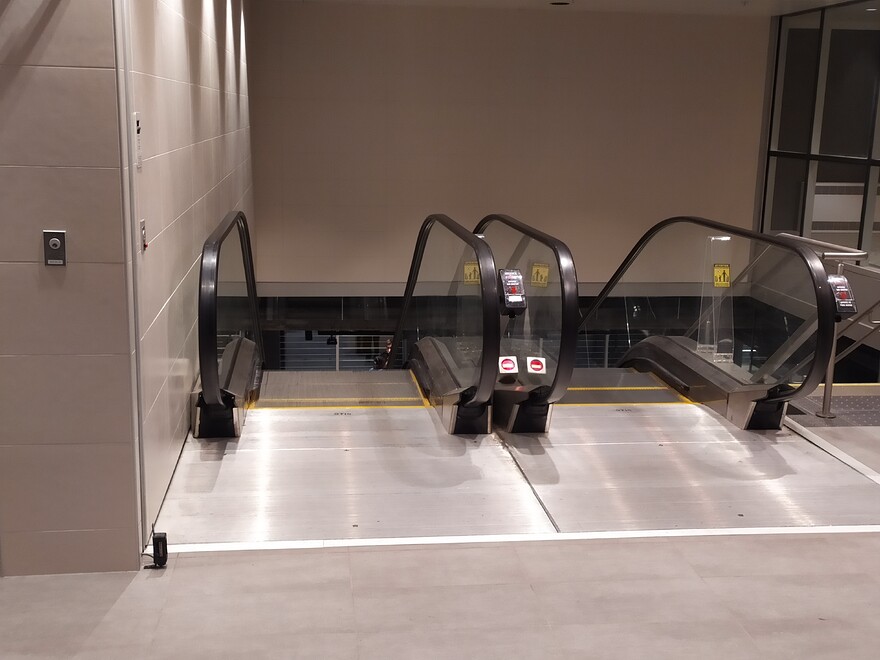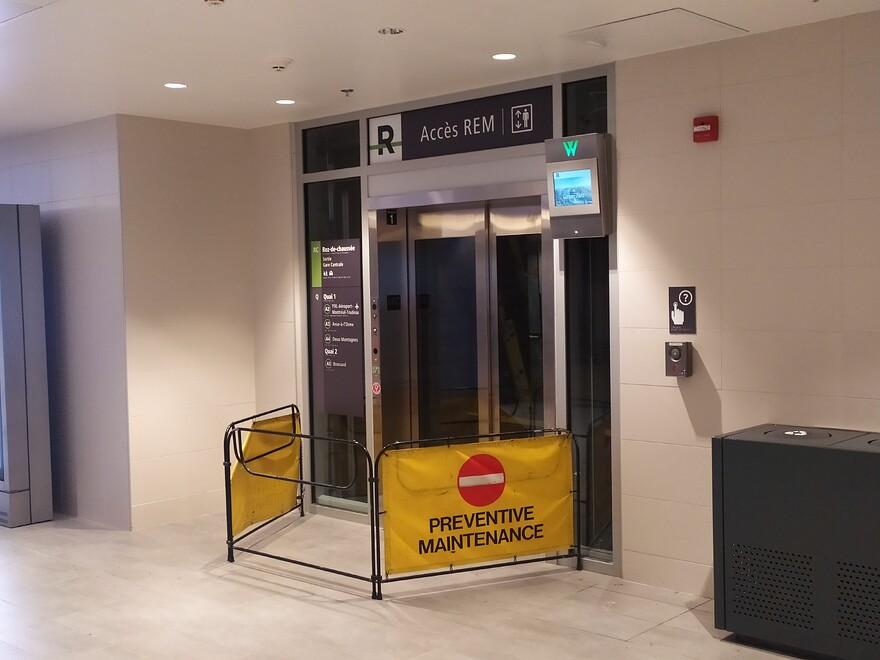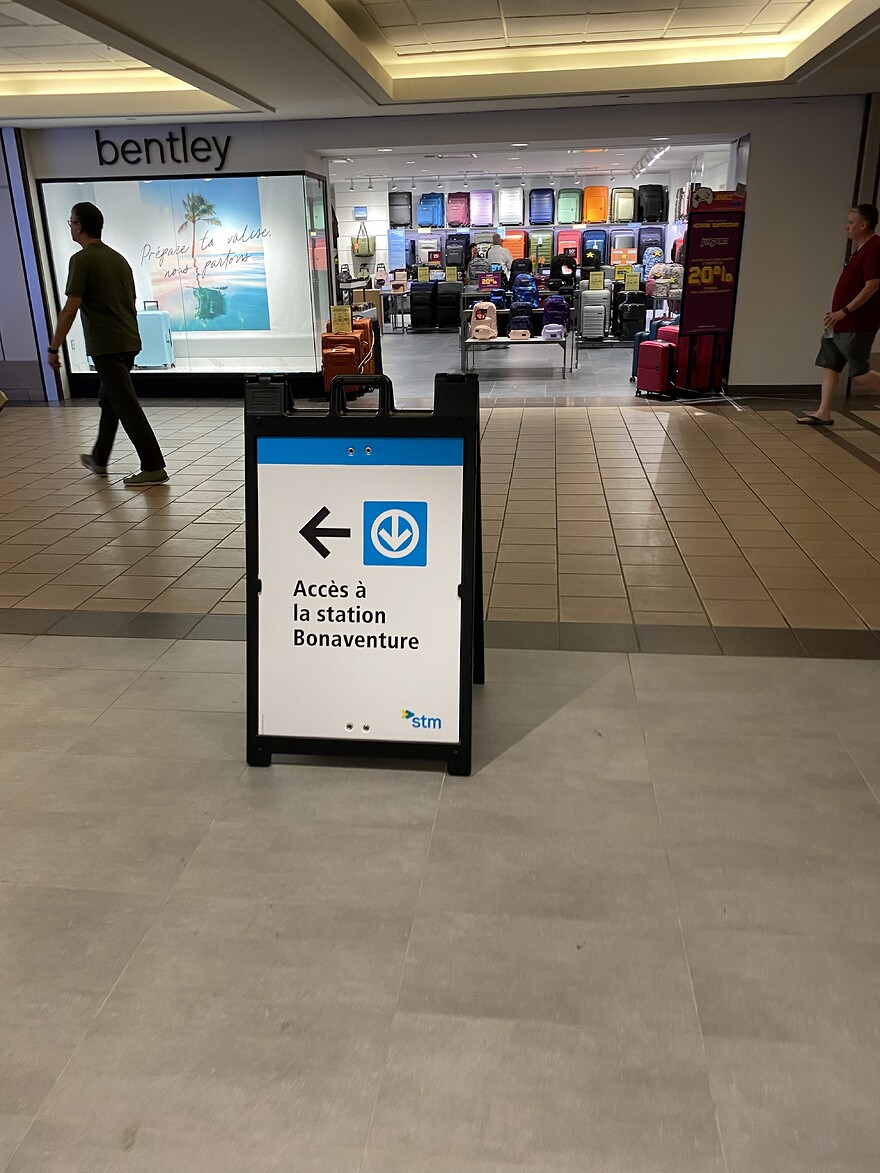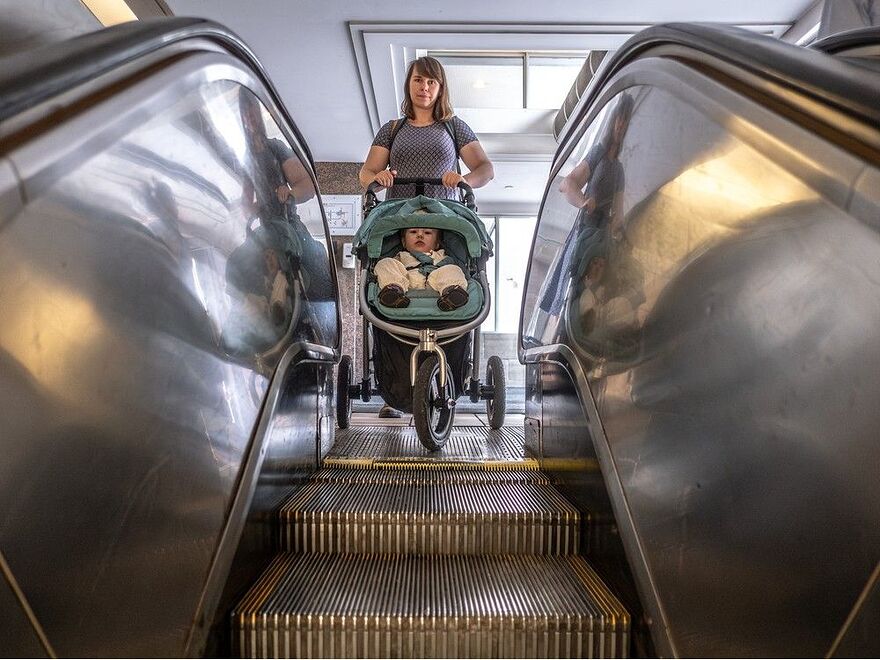The signage is actually temporary because it’ll be replaced by new signs soon!
I was at Gare Centrale this morning, and the escalators were functional! ![]()
À suivre! ![]()
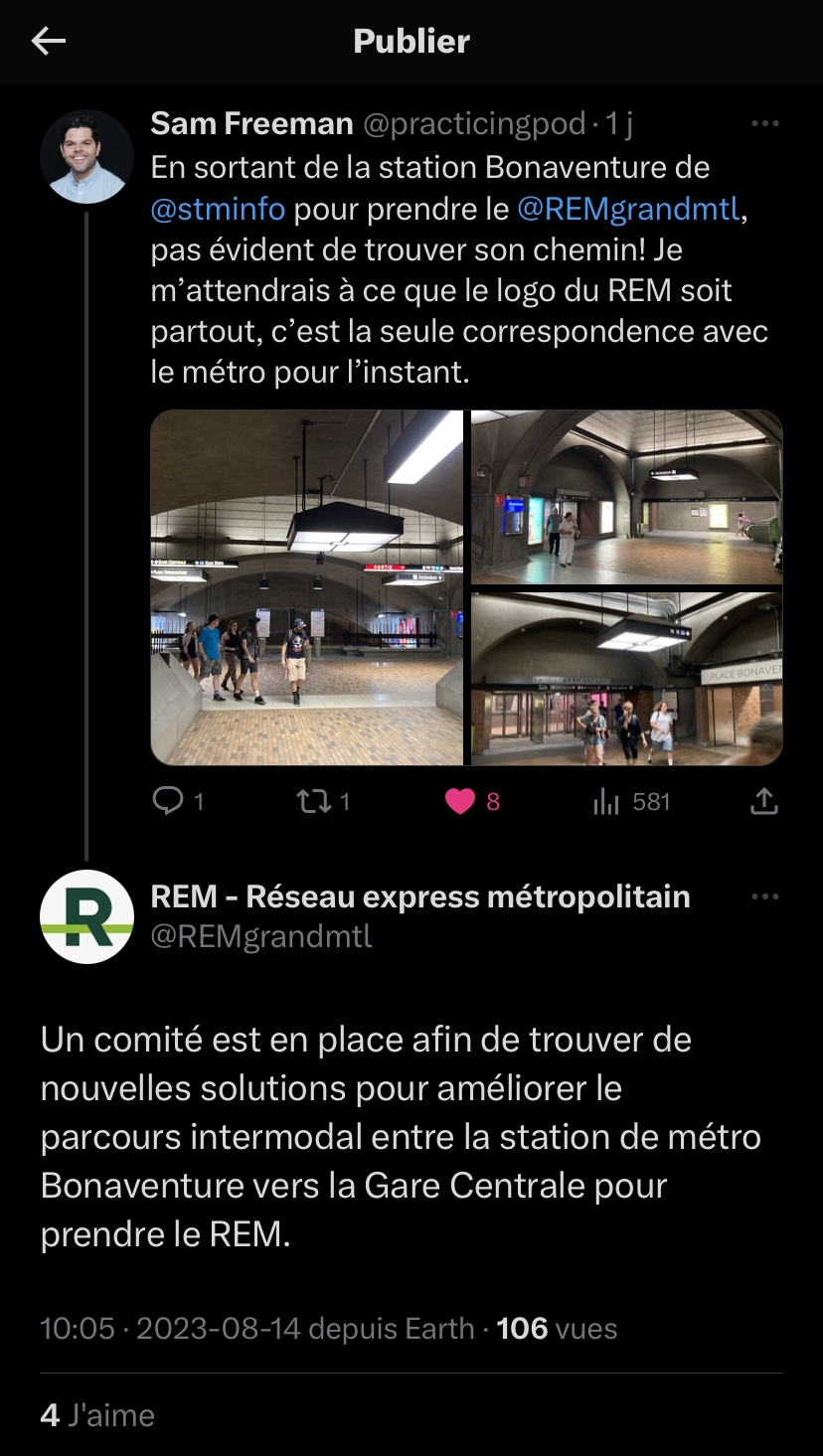
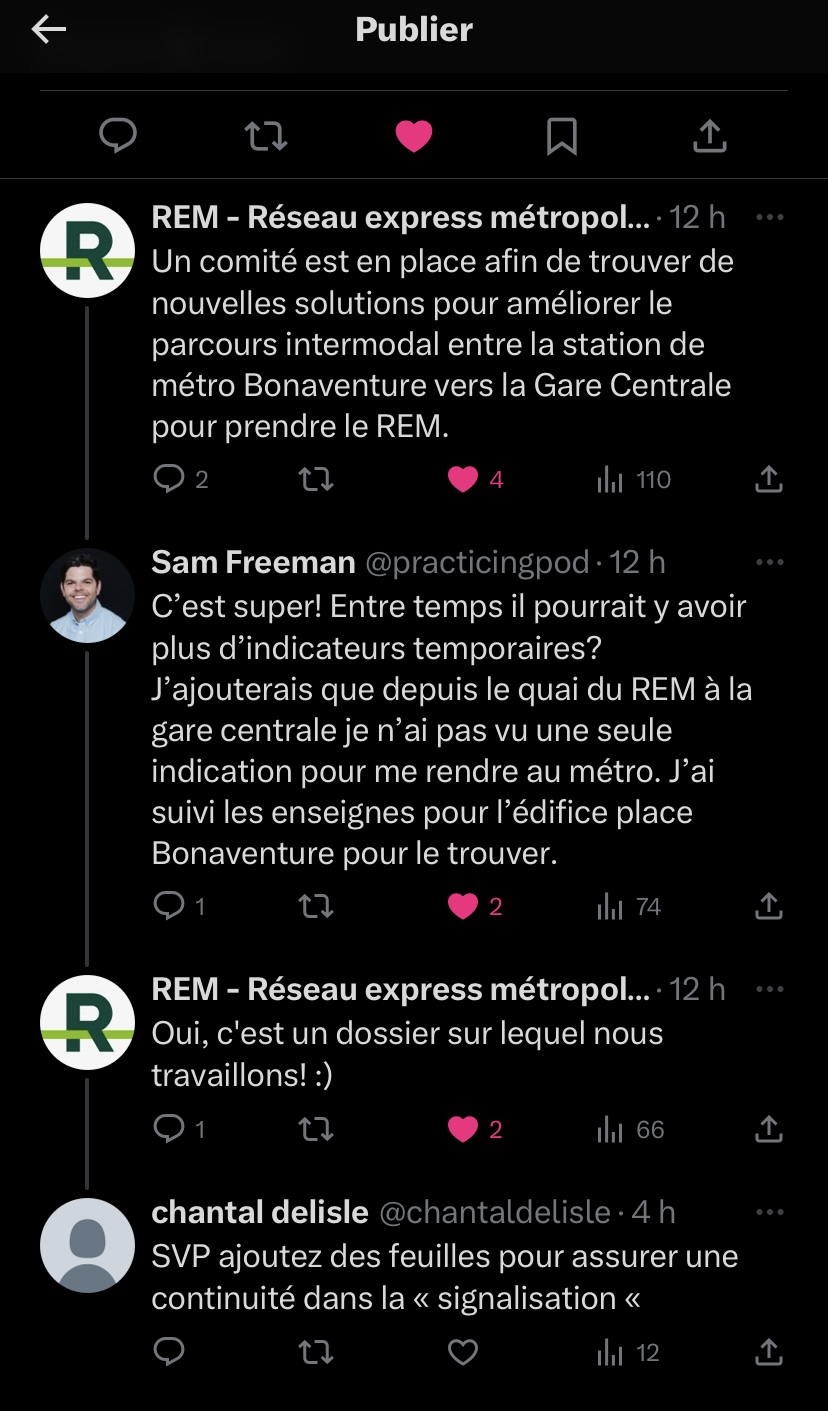
“vaut mieux tard que jamais” j’imagine
“C’est un dossier sur lequel nous travaillons” ???
Ça fait combien d’années que le projet du REM est en branle ?
Surtout, ils ont eu combien de mois d’extra (retard) pour travailler, réviser, améliorer et bonifier le dossier… Ça devrait pas être quelque chose qui est en cours, mais quelque chose qui aurait déjà être fait et prêt, même avant l’ouverture
Lol “a committee is in place” when me and my friend did it within a day (for the installation, another week of just planning where to install, which they should have done before opening)
Don’t get mad at lazy people… they didn’t do anything! ![]()
As far as I care, that resolves the debate of how we should build our metro platforms from now on. Make them all center platforms, and put 2 elevators per platform instead of one per side as you would do when building a side platform. We really could use the redundancy. To be had, this is Gare Centrale. They really should have planned 2 elevators from the start.
I agree. I prefer central platforms as well. I think CDPQi made a mistake to not build Bois-Franc with a central one.
Yeah I don’t understand that at all
Our metro platforms are side platforms (at most stations) because our track is laid in single-bore tunnels. Montreal’s metro was one of the first metro systems to be constructed using single-bore tunnels, and it’s the main reason why our train cars are narrower than most metro trains elsewhere in the world, even though we also use “standard” 1435mm track gauge.
Adding central platforms to single-bore tunnels (like we have at Lionel-Groulx and Snowdon), is technically complex. Here’s an example, but there are dozens of articles like this on the internet from groups analyzing different mass transit construction options:
Bringing BART to Downtown San Jose: Three Things to Consider | SPUR.
Which option will promote quick, direct and intuitive connections between different modes of transportation? Which option will create a safe and comfortable experience for riders?
We have to build stations that make it easy for people to choose and ride BART. The single-bore station doesn’t perform quite as well as the double-bore in terms of promoting intermodal connections and passenger experience.
A double-bore tunnel allows for a wide platform between tracks that is shared by people traveling in both directions. A single-bore tunnel requires a narrower platform that can only be used by people traveling in one direction, like this one in Barcelona. Practically speaking, the single-bore’s narrow platforms could feel crowded if there are a lot of riders (which we hope will be the case) or if there is a delay.
I understand the frustration, but I can totally see how this is more complicated than you think. Even in private corporations that kind of thing would be overly complex and long. I was part of a committee on gender neutral bathrooms in my office, and the whole project was delayed a year because there was disagreement on what pictogram to use, because the building manager had a say, because my firm’s headquarters had a say, because etc. etc. etc. As soon as you add multiple stakeholders to one decision you increase timeline and complexity, it’s the most basic thing they teach you in project management.
Now add to the fact that STM is planning on redoing signage at Bonaventure and that this involves multiple stakeholders… Obviously it will be a mess. Now could this have been done before the opening of REM, totally. That’s where I think the real issue is…
Temporary as measured in decades?
![]()
A quand un signe dehors, la porte extérieur ne dit « acces métro »…
Depends on your scale… because when your scale is long enough, everything ends up temporary ![]()
Problème d’accessiblité entre la Gare centrale et le métro Bonaventure
REM may be accessible, but you can’t get to it by bus or métro in a wheelchair
Many buses to the REM are not equipped for wheelchairs or strollers, and there’s no accessible indoor link from the REM’s Central Station terminus to the Bonaventure métro station.
Author of the article:
Jason Magder • Montreal Gazette
Published Aug 18, 2023 • Last updated 1 hour ago • 5 minute read
Zoë Belk, seen on Aug. 15, 2023, says the escalator in Central Station leading to the tunnel to the Bonaventure métro is too narrow to take her baby stroller down. PHOTO BY DAVE SIDAWAY /Montreal Gazette
Builders of the new Réseau express métropolitain say the train is fully adapted for wheelchairs, but those who lobby for universal accessibility say that’s only partly true.
That’s because many buses taking passengers to the REM are not equipped for wheelchairs or even strollers, and there’s no accessible indoor link from the REM’s Central Station terminus to the Bonaventure métro station just a block away.
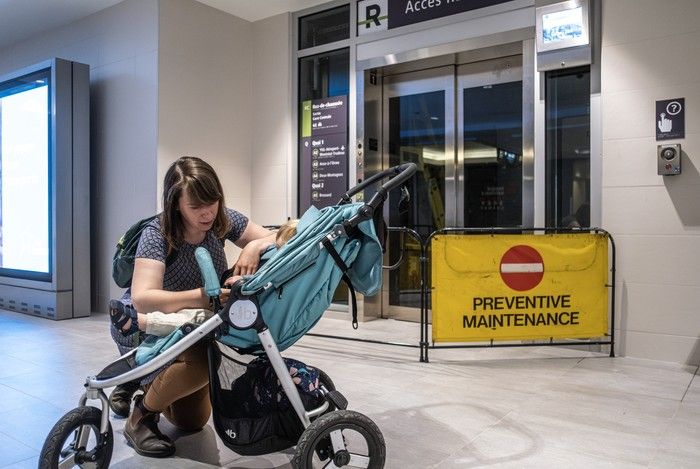
The elevator to the REM has been under maintenance for a while now, points out Zoë Belk, seen Aug. 15, 2023. PHOTO BY DAVE SIDAWAY /Montreal Gazette
Making matters worse, an elevator taking passengers to the main-level concourse has been out of service nearly every day since the beginning of the REM’s run more than two weeks ago.
“It’s a scandal,” said Steven Lapèrriere, director general of the Regroupement des activistes pour l’inclusion au Québec (RAPLIQ), which advocates for universal accessibility. “It’s pretty incredible that in 2023 we haven’t thought of this. It further isolates people who have mobility challenges.”
While buses provided by the Réseau de Transport de Longueuil and the STM allow wheelchairs, those run by Exo and serving the REM in the surrounding regions don’t have space for wheelchairs or even strollers on board. Since 2017, Exo has primarily used coach-style buses, usually seen on long-distance trips. The steep stairs of those buses make it impossible for anyone in a wheelchair to board.
La Prairie resident Zoë Belk commutes daily with her nearly two-year-old child, and he’s too heavy to go in a carrier. She said taking a bus that doesn’t fit a stroller is a hassle for her. And if she’s having trouble, it must be even more difficult for those who need to use a cane, a walker or crutches, she said.
Belk moved to Montreal’s South Shore and didn’t buy a car because she figured that the transit in the area was sufficient to get her to work. Her son is enrolled at a daycare in Griffintown, which is near her work.
Belk takes the métro in the winter when it’s cold, which is just an elevator ride away from the South Shore bus terminal.
However, this coming winter, it will be difficult for her to access that station because the REM takes passengers to Central Station, and its connection to the Bonaventure station is not accessible. The underground link to the Bonaventure métro station involves taking narrow escalators and rotating doors, which are challenging for those walking with mobility aids, parents with strollers, and especially people in wheelchairs.
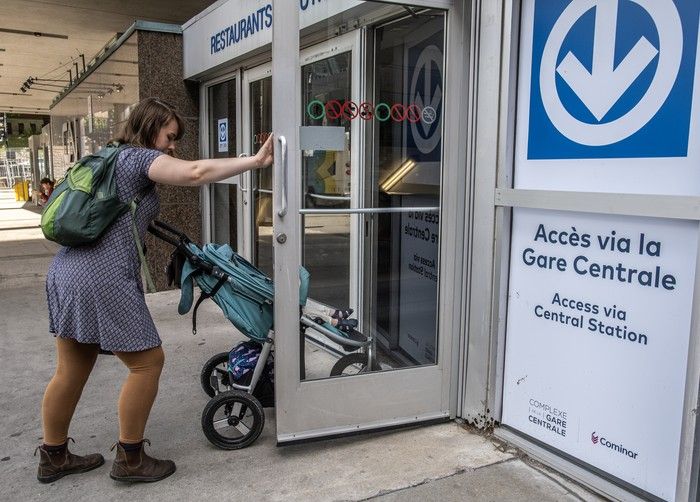
Zoë Belk, seen here on Aug. 15, 2023, wishes the métro entrance doors at Central Station on de la Gauchetière St. were automatic. PHOTO BY DAVE SIDAWAY /Montreal Gazette
That means when Belk arrives in Central Station, she can’t access the tunnel to the Bonaventure métro, nor can anyone in a wheelchair. The only other option is to walk outside and cross the street to 1000 de la Gauchetière, but that door is not motorized, so it’s very difficult for Belk or anyone in a wheelchair to open it.
Technically, the REM represents a step backward for mobility in the Montreal region. That’s because after several years of construction that predated the REM, the old terminus for South Shore buses was equipped in 2019 with an elevator linking it with the Bonaventure métro station, and another one linking to street level.
However, since the REM began service on July 31, the South Shore terminal, located in 1000 de la Gauchetière, is no longer the hub for transport to the South Shore. Nearly all public transit to and from the South Shore is now by the REM’s Central Station terminus, which is kitty corners away from the old bus terminus.
Belk has lodged numerous complaints about the lack of accessibility, but so far, nothing has changed.
“I made some suggestions, like if they can open up the baggage compartment for me, that would help,” Belk said. “But they just said no.”
In a written response, Exo spokesperson Eric Edström said the transit agency will be requiring all buses to be accessible for wheelchairs and strollers when contracts with suppliers are renewed.
“These requirements will be included for new vehicles that will gradually replace those used by suppliers since Exo was created in 2017,” Edström wrote.
He did not explain why the agency didn’t require its buses to be accessible when it signed its first contract six years ago.
As for strollers, Edström admitted it’s not obvious where they can be placed on board a bus. He said strollers must be folded and be in an area where they don’t restrict passage within the bus.
RAPLIQ’s Lapèrriere said it’s unacceptable that Exo, which is a relatively new agency, failed to ensure that their buses can be adapted for those with mobility issues. With a supposedly universally accessible light-rail network now taking people to Central Station, it is imperative Exo and other agencies offering transit service to the REM figure out how to also allow wheelchairs on board, he said.
He added that he’s also concerned that escalators and elevators in Central Station are often broken down.
“That’s a big deal for someone who is elderly or who has mobility issues,” he said. “You’ll tell me breakdowns can happen. That’s true, but it takes a long time to repair these when they concern people with mobility issues.”
Jessica Théroux, a spokesperson for CDPQ Infra, which owns and operates the REM, blamed the elevator issue on initial bugs during the breaking-in process of the new network. She said teams are on hand working on the problem.
Laperrière added that the city’s transit planners should have figured out how to make the passageway to the Bonaventure station accessible in the five years of lead time that they had before the REM entered into service.
Speaking for the Autorité régionale de transport métropolitain (ARTM), Séléna Champagne said the solution to the problem isn’t simple, since Central Station wasn’t originally conceived to be accessible.
“It’s a complicated file involving numerous actors, like transit operators, municipal authorities and building owners,” Champagne wrote. “The ARTM has mobilized the stakeholders to form a committee to ensure the best possible co-operation. Some steps are already being taken to find a solution to simplify the transit for those with mobility issues.
“Many scenarios have been studied, but they have proven to be impossible because of the complexity of the buildings, the heritage issues involved and issues like telecommunication systems and evacuation passageways that can’t be moved. Architects are now trying to find other solutions.”
She added that the ARTM considers accessibility issues in all projects that it manages.
Lapèrriere isn’t impressed with that answer, as it is one he has heard all too often.
J’ai peur pour les ascenseurs de Édouard-Montpetit tout d’un coup.
